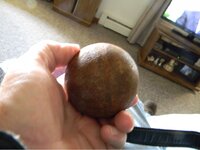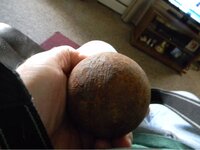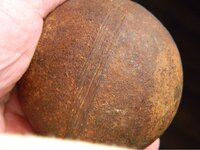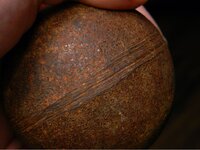Old Dude
Gold Member
- Feb 20, 2013
- 8,799
- 9,850
- 🏆 Honorable Mentions:
- 2
- Detector(s) used
- Fisher F75, Garrett ATPro, Garrett GTAx 500
- Primary Interest:
- Metal Detecting
I would love to be able to say I found this, but my brother in law gave it to me. His nephew has found four or five now at his worksite in Ky. There was a battle site several miles away, and I have heard stories that during the retreat, skirmishes happened just on the other side of the hilltop near this site. I have also heard that there was an ironworks site somewhere in the vicinity of the find. All the balls are the same size he found and according to my bath scale, it weighs 3.4 lbs. As you can see, it appears the casting marks have been ground away. Is this a CW era ball or some other time frame? Thanks for replies.








 .
.


